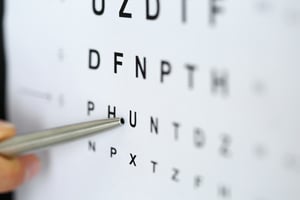Could My Vision Be Better?
Your vision could possibly be improved. As a Doctor of Optometry who has been practicing since 1986, just the word “vision” can get me talking for hours, if not days. But let me summarize many of the aspects of vision and then I’ll address the next steps toward improving your vision.
Visual Acuity
 When most people think about vision, they’re considering the clarity or sharpness of their vision. This is typically measured using a Snellen eye chart with a resulting measure of 20/20, etc. That fraction refers to the smallest line on the chart that you can read. For example, the large E at the top of the chart rates 20/200 visual acuity.
When most people think about vision, they’re considering the clarity or sharpness of their vision. This is typically measured using a Snellen eye chart with a resulting measure of 20/20, etc. That fraction refers to the smallest line on the chart that you can read. For example, the large E at the top of the chart rates 20/200 visual acuity.
Contrast Sensitivity
The Snellen eye chart shows black letters on a white background. But that’s not typically what you’re trying to see. Night driving, glare, and low lighting require higher levels of contrast sensitivity. Testing for contrast sensitivity involves a Pelli Robson chart where the letters on the eye chart are faded from black to very light shades of gray on a white background.
Color Vision
Color vision deficiency, or color blindness, is tested using an Ishihara Color Vision test where you identify a number within a pattern of dots of various colors. Those with color blindness typically won’t be able to see the number at all. More detailed testing requires a Farnsworth-Munsell 100 Hue test. Here you arrange small disks with varying hues of colors. This test identifies variations in your color vision across the full color spectrum.
Depth Perception
Depth perception refers to our ability to see the world in three dimensions and judge the distance between different objects. It requires vision from both eyes, or stereopsis. We test this with random-dot stereograms and contour stereotests.
Vision Changes
There are many, many factors that can cause your vision to change. One that we can’t get around is that as we age, our vision changes. Typical causes are presbyopia, difficulty seeing objects up close; cataracts, a clouding of the eyes lens; macular degeneration, loss of central vision; floaters, tiny particles that drift across the eye; glaucoma, increased pressure within the eye; diabetic retinopathy, complications for diabetes; and more.
There are also a few factors that cause our vision to change from day-to-day or week-to-week. These include changes in blood sugar levels, dry eyes, hormone fluctuations, and Texas allergy flare-ups. Disrupted sleep patterns and stress levels can also impact your vision.
Take Care of Your Vision
That’s a short list of vision problems and their associated tests. To improve your vision, whether that be visual acuity or any other aspect, you first need to establish a baseline for your vision as it is today.
We can take care of this. We can conduct a thorough examination to identify any concerns and get you on the road to improving your vision.
Use our contact form or call us at 972-612-2099.
Disclaimer: The content on this blog is not intended to be a substitute for professional medical advice, diagnosis, or treatment. Always seek the advice of qualified health providers with questions you may have regarding medical conditions.








